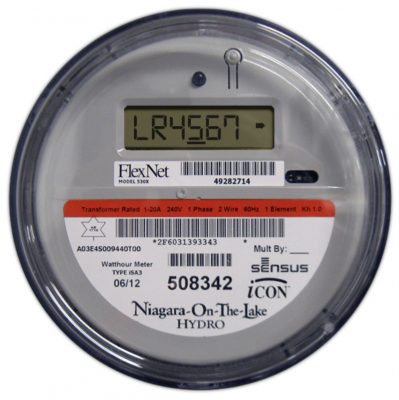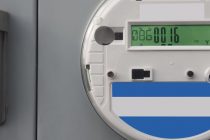“Smart” meters do not satisfy Building Biology Institute’s standards for a healthy built environment. The primary problems are the wireless communication with high frequency electromagnetic radiation and the disturbing peculiarity of the transients added to the house wiring called electromagnetic interference (EMI).
You can download this fact sheet by clicking here.
Utility meters are used to measure consumption of commodities such as water, gas and electricity. Utility meters that measure electricity consumption operate by continuously measuring the voltage and current consumed to calculate energy in kilowatt-hours for which you are billed. Gas and water meters measure flow rates. Meters fall into two basic categories, electromechanical (also known as analog) and electronic.
The electronic or digital utility meters have been around since the early 1990’s. The first remote communicating electric meters, AMR (Automated Meter Reading) meters, started replacing the traditional analog electric meters in the middle to late 1990’s, a patent for the technology was filed in 1997. Some analog meters were modified with a transmitting device making them hybrids. The electricity “smart” meter is technically known as an AMI (Advanced Metering Infrastructure) meter and started rolling out in the early 2000’s. The key difference of the AMI meter is its two-way communication capability; it can receive data as well as transmit it. The AMI can be a wired network but that is not what utilities around the world are using; preferring the easier, cheaper wireless option.
Other potential problems inherent with the AMI meters are increased fire risk, increased electricity bills, breached privacy, shorter technology life span, and security.
It is highly probable digital meters (“smart” meters), whether AMR, AMI or non-communicating, are an assault on the biology and ecology of all living organisms.
Extensive research by technical experts has shown no benefit to consumers from electricity smart meters. Digital smart meters are a high cost, environmentally unsustainable way to automate meter reading. We have yet to know conclusively the long-term impact on biology or ecology, but the evidence is increasingly indicative of cumulative harm. The high intensity, pulsed radiation and potentially unique EMI from digital meters is an incremental increase on top of an already saturated EMF environment from the proliferation of cell phone technology (phones and antennas), available anywhere Wi-Fi, and a proliferation of wireless devices in the home. This level will increase as we enter the era of the Internet of Things (IoT) with Fifth Generation (5G) cellular technology.
IBE does not support deployment of “smart” meters. Digital meters fail to meet several of our principles of a healthy and sustainably built environment. Number one among them is the “precautionary principle” related to possible health and ecology impact. We recommend, especially for people experiencing EHS, to opt-out of AMI systems and to request retention or reinstallation of an analog electric meter whenever possible. When opting out is not possible, we recommend the use of shielding strategies.
Want to learn more on this issue? Click the comprehensive online course, here below.


